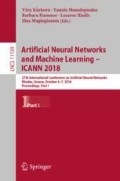Abstract
Multiplicative or divisive changes in tuning curves of individual neurons to one stimulus (“input”) as another stimulus (“modulation”) is applied, called gain modulation, play an important role in perception and decision making. Since the presence of modulatory synaptic stimulation results in a multiplicative operation by proportionally changing the neuronal input-output relationship, such a change affects the sensitivity of the neuron but not its selectivity. Multiplicative gain modulation has commonly been studied at the level of single neurons. Much less is known about arithmetic operations at the network level. In this work we have evolved small networks of spiking neurons in which the output neurons respond to input with non-linear tuning curves that exhibit gain modulation—the best network showed an over 3-fold multiplicative response to modulation. Interestingly, we have also obtained a network with only 2 interneurons showing an over 2-fold response.
Access this chapter
Tax calculation will be finalised at checkout
Purchases are for personal use only
References
Ayaz, A., Chance, F.S.: Gain modulation of neuronal responses by subtractive and divisive mechanisms of inhibition. J. Neurophysiol. 101, 958–968 (2009)
Brette, R., Gerstner, W.: Adaptive exponential integrate-and-fire model as an effective description of neuronal activity. J. Neurophysiol. 94, 3637–3642 (2005)
Chance, F.S., Abbott, L.F., Reyes, A.D.: Gain modulation from background synaptic input. Neuron 35, 773–782 (2002)
Götz, K.G.: The optomotor equilibrium of the Drosophila navigation system. J. Comp. Physiol. 99, 187–210 (1975)
Hildebrandt, K.J., Benda, J., Hennig, R.M.: Multiple arithmetic operations in a single neuron: the recruitment of adaptation processes in the cricket auditory pathway depends on sensory context. J. Neurosci. 31, 14142–14150 (2011)
Koch, C., Poggio, T.: Multiplying with synapses and neurons. In: Single Neuron Computation, pp. 315–345. Elsevier (1992)
Murphy, B.K., Miller, K.D.: Multiplicative gain changes are induced by excitation or inhibition alone. J. Neurosci. 23, 10040–10051 (2003)
Naud, R., Marcille, N., Clopath, C., Gerstner, W.: Firing patterns in the adaptive exponential integrate-and-fire model. Biol. Cybern. 99, 335–347 (2008)
Peña, J.L., Konishi, M.: Robustness of multiplicative processes in auditory spatial tuning. J. Neurosci. 24, 8907–8910 (2004)
Salinas, E., Abbott, L.: Coordinate transformations in the visual system: how to generate gain fields and what to compute with them. Progress Brain Res. 130, 175–190 (2001)
Salinas, E., Sejnowski, T.J.: Gain modulation in the central nervous system: where behavior, neurophysiology, and computation meet. Neuroscientist 7, 430–440 (2001)
Schnupp, J.W., King, A.J.: Neural processing: the logic of multiplication in single neurons. Curr. Biol. 11, 640–642 (2001)
Wróbel, B., Abdelmotaleb, A., Joachimczak, M.: Evolving networks processing signals with a mixed paradigm, inspired by gene regulatory networks and spiking neurons. In: Di Caro, G.A., Theraulaz, G. (eds.) BIONETICS 2012. LNICST, vol. 134, pp. 135–149. Springer, Cham (2014). https://doi.org/10.1007/978-3-319-06944-9_10
Wróbel, B., Joachimczak, M.: Using the genetic regulatory evolving artificial networks (GReaNs) platform for signal processing, animat control, and artificial multicellular development. In: Kowaliw, T., Bredeche, N., Doursat, R. (eds.) Growing Adaptive Machines. SCI, vol. 557, pp. 187–200. Springer, Heidelberg (2014). https://doi.org/10.1007/978-3-642-55337-0_6
Yaqoob, M., Wróbel, B.: Robust very small spiking neural networks evolved with noise to recognize temporal patterns. In: Proceedings of the 2018 Conference on Artificial Life, ALIFE 2018, pp. 665–672. MIT Press (2018)
Acknowledgements
This work was supported by the Polish National Science Center (project EvoSN, UMO-2013/08/M/ST6/00922). MAK acknowledges the support of the PhD program of the KNOW RNA Research Center in Poznan (No. 01/KNOW2/2014).
Author information
Authors and Affiliations
Corresponding author
Editor information
Editors and Affiliations
Rights and permissions
Copyright information
© 2018 Springer Nature Switzerland AG
About this paper
Cite this paper
Khan, M.A., Steuber, V., Davey, N., Wróbel, B. (2018). Spiking Neural Networks Evolved to Perform Multiplicative Operations. In: Kůrková, V., Manolopoulos, Y., Hammer, B., Iliadis, L., Maglogiannis, I. (eds) Artificial Neural Networks and Machine Learning – ICANN 2018. ICANN 2018. Lecture Notes in Computer Science(), vol 11139. Springer, Cham. https://doi.org/10.1007/978-3-030-01418-6_31
Download citation
DOI: https://doi.org/10.1007/978-3-030-01418-6_31
Published:
Publisher Name: Springer, Cham
Print ISBN: 978-3-030-01417-9
Online ISBN: 978-3-030-01418-6
eBook Packages: Computer ScienceComputer Science (R0)

